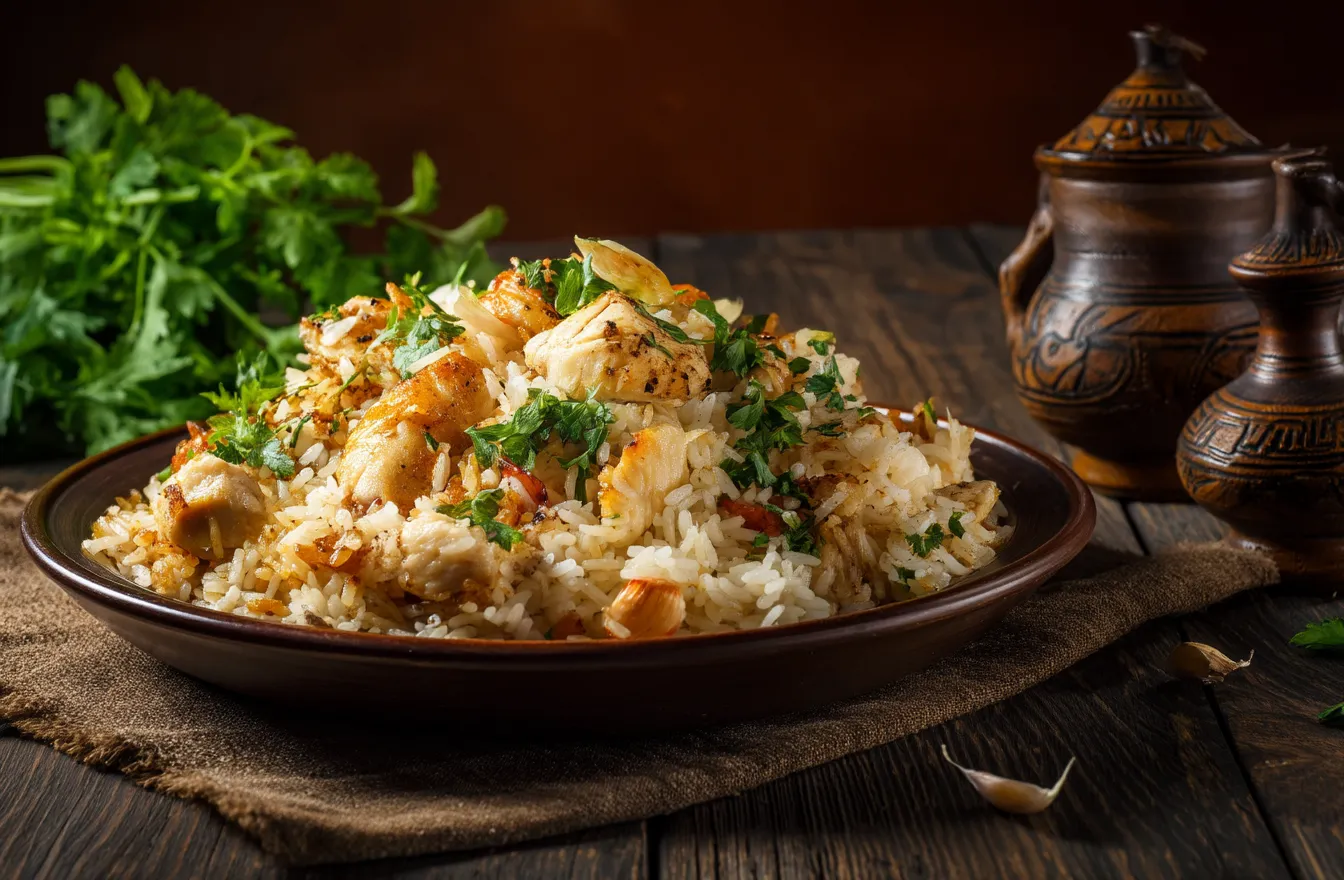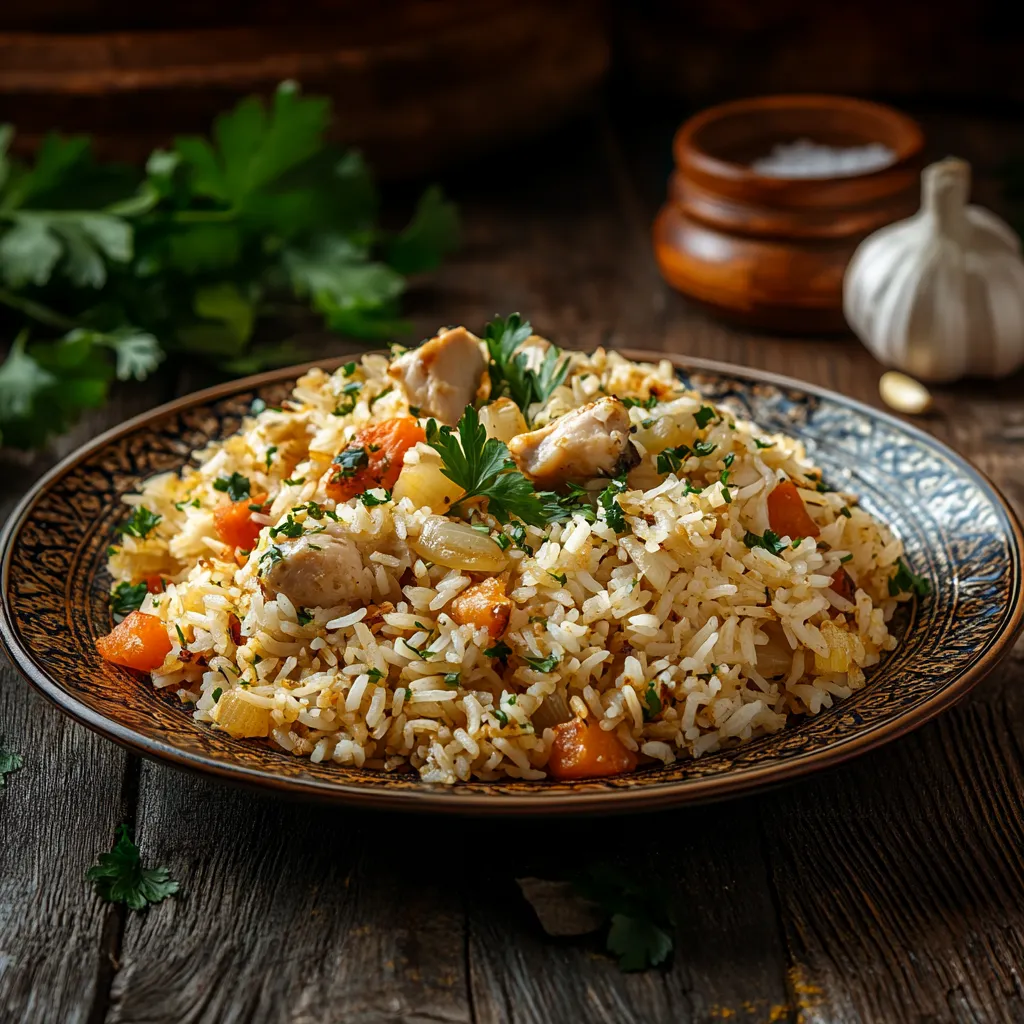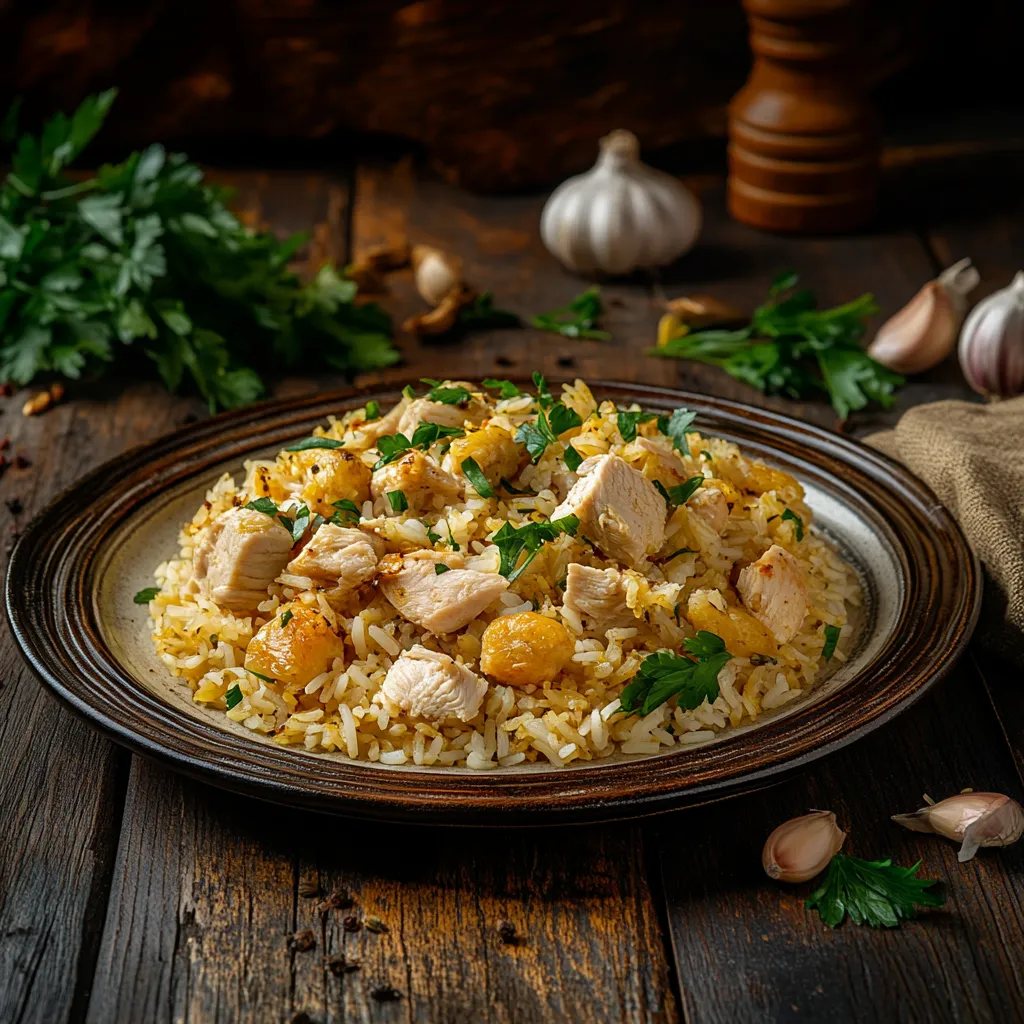 Save
Save
This hearty Pilaf with Chicken and Garlic has been a cornerstone of Kazakh cuisine for generations. Known locally as Paludeh, this comforting one-pot meal combines tender chicken pieces with aromatic rice and whole garlic bulbs for a dish that's both satisfying and impressive. The flavors meld together beautifully, creating something far greater than the sum of its simple parts.
I first discovered this dish during my exploration of Central Asian cooking and was immediately struck by how such simple ingredients could create something so deeply satisfying. My family now requests it regularly when we want something hearty yet special enough for weekend dinners.
Ingredients
- Long grain rice preferably basmati for its fragrant aroma and ability to remain separate when cooked
- Bone in chicken thighs or drumsticks with skin for maximum flavor development
- Large onion thinly sliced providing sweetness and foundation for the dish
- Carrots cut into matchsticks adding color and subtle sweetness
- Whole garlic bulb unpeeled with top trimmed becomes meltingly soft during cooking
- Vegetable oil for its neutral flavor that lets other ingredients shine
- Ground cumin bringing warm earthy notes essential to Central Asian cuisine
- Paprika for color and mild pepper flavor
- Ground black pepper adding gentle heat
- Salt to taste enhancing all other flavors
- Chicken broth or water as cooking liquid infusing everything with savory goodness
Step-by-Step Instructions
- Prepare the Chicken
- Season chicken pieces lightly with salt and pepper all over. Make sure to pat them completely dry first with paper towels to ensure proper browning. This creates a foundation of flavor for the entire dish.
- Create the Flavor Base
- Heat oil in a large heavy bottomed pot over medium heat until shimmering. Add chicken pieces skin side down first and brown thoroughly for about 4 minutes before turning to brown all sides. This should take 8 to 10 minutes total. The caramelization creates deep savory notes. Remove chicken and set aside.
- Develop the Aromatics
- In the same pot with all those flavorful chicken drippings add the sliced onions. Cook for about 5 minutes until they become translucent and soft. Add the carrot matchsticks and continue cooking for another 3 to 4 minutes until they just begin to soften but still maintain texture.
- Build the Spice Layer
- Add cumin and paprika to the vegetables stirring constantly for about 30 seconds. The heat will toast the spices releasing their essential oils and intensifying their flavors. This brief cooking prevents bitterness while maximizing aroma.
- Create the Rice Foundation
- Add the uncooked rice over the vegetable mixture spreading it in an even layer. Do not stir it at this point as the layering is crucial for proper texture development. The rice will cook in its own distinct layer.
- Arrange the Protein
- Place the browned chicken pieces on top of the rice distributing them evenly for balanced cooking. Their juices will slowly seep into the rice as everything cooks together.
- Position the Garlic
- Nestle the whole garlic bulb cut side up in the center of the pot. This allows it to steam and roast simultaneously becoming incredibly soft and sweet through the cooking process.
- Add Cooking Liquid
- Carefully pour chicken broth or water over everything ensuring the liquid covers the rice by about 1 centimeter. Pour gently along the side of the pot to avoid disturbing the carefully arranged layers.
- Slow Cook to Perfection
- Bring to a boil then immediately reduce heat to low. Cover tightly with a lid and simmer undisturbed for 20 to 25 minutes. The rice will absorb the liquid and become tender while the chicken finishes cooking through.
- Rest Before Serving
- Turn off the heat without removing the lid and allow everything to rest for 10 minutes. This critical step allows the moisture to redistribute throughout the dish for perfect texture and prevents gumminess in the rice.
 Save
Save
The unassuming whole garlic bulb is truly the secret star of this dish. While it might seem strange to cook an entire head of garlic, the slow cooking transforms it into something magical. My grandmother would always encourage everyone to squeeze out the soft cloves and mix them into their portion, creating little pockets of sweet garlicky goodness throughout the dish.
Storage Wisdom
This pilaf actually improves with time as the flavors continue to develop. Store leftovers in an airtight container in the refrigerator for up to four days. When reheating, add a small splash of water or broth to rehydrate the rice and prevent it from drying out. For best results, reheat gently on the stovetop over medium-low heat rather than using high microwave power which can make the chicken tough.
Ingredient Substitutions
While traditional Kazakh Paludeh uses chicken, you can create equally delicious versions with other proteins. Lamb shoulder cut into chunks works beautifully and adds a slightly richer flavor profile. For a vegetarian version, use large portobello mushrooms cut into chunks and increase the vegetable content with bell peppers. Replace the chicken broth with vegetable stock or mushroom broth for depth. The cooking method remains the same regardless of protein choice.
Cultural Significance
In Kazakhstan, pilaf dishes like Paludeh are more than just food they represent hospitality and community. Traditionally prepared for special occasions and family gatherings, the communal nature of serving from one large pot symbolizes unity and sharing. The recipe has been passed down through generations with each family developing their own slight variations. The whole garlic bulb is often considered a prize, sometimes given to the guest of honor or divided among everyone at the table as a sign of goodwill.
Serving Suggestions
Present this pilaf in its traditional form by bringing the entire pot to the table for a dramatic presentation. Remove the garlic bulb and place it on a small dish separately, allowing diners to take cloves as desired. Fresh herbs like chopped dill or cilantro sprinkled over the top add brightness and color. A simple side of yogurt mixed with a little salt and minced cucumber provides a cooling contrast to the warm spices. For a complete experience, serve with flatbread to scoop up every last grain of flavorful rice.
 Save
Save
Recipe FAQs
- → Why is bone-in chicken recommended for Kazakh Paludeh?
Bone-in chicken releases more flavor during the cooking process, creating a richer broth that gets absorbed by the rice. The bones help keep the meat moist and tender while adding depth to the entire dish. While boneless chicken can be substituted, it won't provide the same depth of flavor that makes traditional Paludeh so special.
- → What makes the whole garlic bulb important in this dish?
The whole garlic bulb is a signature element of Kazakh Paludeh. As it cooks, the garlic softens completely, transforming from sharp and pungent to sweet and mellow. When served, diners can squeeze out the soft garlic cloves and mix them into their portion, adding a delicious aromatic quality that perfumes the entire dish without overwhelming it.
- → Can I prepare Kazakh Pilaf in advance for a gathering?
Yes, this dish actually benefits from some resting time as the flavors continue to develop. You can prepare it 1-2 hours before serving and keep it covered at room temperature. For longer storage, refrigerate after cooling and gently reheat by steaming or in the microwave with a splash of water to restore moisture.
- → What's the best rice variety to use for authentic Paludeh?
Traditionally, long-grain rice varieties work best for Kazakh Paludeh. Basmati is ideal because it cooks up fluffy with distinct grains that don't clump together. The long grains allow for better absorption of the flavors while maintaining their structure during the long cooking process.
- → Why shouldn't I stir the rice after layering it?
The no-stir technique is crucial for proper texture in Paludeh. Layering the ingredients and leaving them undisturbed allows the rice at the bottom to develop a golden crust (similar to Persian tahdig) while ensuring even cooking throughout. Stirring would disrupt this texture development and potentially make the rice gummy.
- → What side dishes pair well with Kazakh Pilaf?
While Paludeh is a complete meal on its own, it pairs beautifully with simple accompaniments like a fresh cucumber and tomato salad, pickled vegetables, or yogurt sauce. In Kazakh tradition, it might be served with flatbread to scoop up the flavorful rice and soak up any juices.
